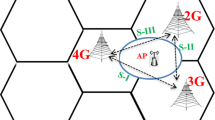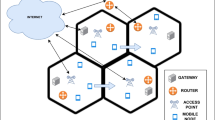Abstract
In this paper, we investigate a call-admission and handoff-control framework for multi-tier cellular networks. We first propose and compare Call-Admission Control (CAC) algorithms based on the cell-dwelling time, by studying their impact on the handoff-call dropping and new-call blocking probabilities and the channel partitioning between the two tiers. Our results show that a simple, cell-dwelling-time-insensitive algorithm performs better under various mixes of user mobilities and call types. Moreover, there is an optimal channel partition of the overall spectrum between the tiers which minimizes the dropping and blocking probabilities for the two different CAC algorithms studied in this paper. Once the call is admitted into the network, we propose and compare various handoff- queuing strategies to reduce the call dropping probability. We show that implementing a queuing framework in one of the tiers (especially the upper, i.e., macrocellular, tier), results in a significant reduction in the dropping probability.
Similar content being viewed by others
References
Scheibenbogen, M., Clausen, S., & Guntsch, A. (1999). Dynamic channel allocation in hierarchical cellular systems. In Proc., vehicular technology conference, Vol. 4, pp. 2418–2422.
Sung, C. W., & Shum, K. W. (1999). Channel assignment and layer selection in hierarchical cellular system with fuzzy control. In Proc., vehicular technology conference, Vol. 4, pp. 2433–2477.
Greenstein C.-L.I.L., Gitlin R.D. (1993). A microcell/macrocell cellular architecture for low- and high-mobility wireless users. IEEE Journal on Selected Areas in Communications 11(6): 885–890
Anpalagan, A. S., & Katzela, I. (1999). Overlaid cellular system design with cell selection criteria for mobile wireless users. In Proc., Canadian conference on electrical computer engineering, May 1999, Vol. 1, pp. 24–28.
Chang C., Chang C.-J., Luo K.R. (1999). Analysis of a hierarchical cellular system with reneging and dropping for waiting new and handoff calls. IEEE Transactions on Vehicular Technology 8(4): 1080–1091
Lagrange, X., & Godlewski, P. (1999). Performance of a hierarchical cellular network with mobility-dependent handover strategies. In Proc., vehicular technology conference, April 1999, Vol. 3, pp. 1868–1872.
Cimone, G., Weerakoon, D. D., & Aghvami, A. H. (1999). Performance eveluation of a two layer hierarchical cellular system with variable mobility user using multiple class applications. In Proc., IEEE vehicular technology conference, September 1999, pp. 2835–2839.
Ho C.J., Lea C.T., Stuber G.L. (2001). Call admission control in the microcell/macrocell overlaying system. IEEE Transactions on Vehicular Technology 50(4): 992–1003
Choi, C. H., Kim, M. I., Kim, T. J., & Kim, S. J. (2001). A call admission control mechanism using mpp and 2-tier cell structure for mobile multimedia computing. In Proc., conference on computer communications and networks, pp. 581–584.
Ekici E., Ersoy C. (2001). Multi-tier cellular network dimensioning. Wireless Networks 7(4): 401–411
Begain, K., Rozsa, G., Pfening, A., & Telek, M. (2002). Performance analysis of gsm networks with intelligent under lay-overlay. In 7th symposium on computers and communications, pp. 135–141.
Dru, M.-A., & Saada, S. (2001). Location-based mobile services: The essentials. Tech. Rep., Alcatel Telecommunications Review, 1st Quarter 2001.
Nokia, http://www.nokia.com, Mobile Location Services, 2001.
Akyildiz I.F., Wang W. (2002). A dynamic location management scheme for next-generation multitier pcs systems. IEEE Transactions on Wireless Communications 1(1): 178–189
Murphy, J. B., & Morgan, S. L. (1993). A satellite-based position location system for global data collection and messaging. In Proc., MILCOM, October 1993, Vol. 2.3, pp. 374–378.
Yeung K.L., Nanda S. (1996). Channel management in microcell/macrocell cellular radio systems. IEEE Transactions on Vehicular Technology 45(4): 601–612
Jabbari B., Fuhrmann W. (1997). Teletraffic modelling and analysis of flexible hierarchical cellular networks with speed sensitive handoff strategy. IEEE Journal on Selected Areas in Communications 15(8): 1539–1548
Lin Y.-B., Mohan S., Noerpel A. (1994). Queueing priority channel assignment strategies for pcs hand-off and initial access. IEEE Transactions on Vehicular Technology 43(3): 704–712
Redl, S. M., Weber, M. K., & Oliphant, M. W. (1995). An introduction to GSM. Artech House Mobile Communications Series. Artech House.
Thomas, R., Gilbert, H., & Mazziotto, G. (1988). Influence of the movement of the mobile stations on the performance of a radio cellular network. In Proc., third nordic seminar on digital land mobile radio communications, September 1988.
Author information
Authors and Affiliations
Corresponding author
Rights and permissions
About this article
Cite this article
Pandey, V., Ghosal, D., Mukherjee, B. et al. Call admission and handoff control in multi-tier cellular networks: algorithms and analysis. Wireless Pers Commun 43, 857–878 (2007). https://doi.org/10.1007/s11277-007-9307-y
Received:
Accepted:
Published:
Issue Date:
DOI: https://doi.org/10.1007/s11277-007-9307-y




